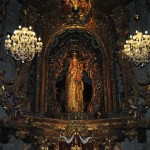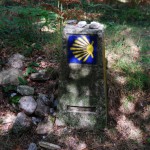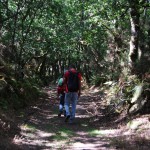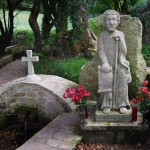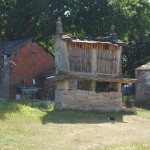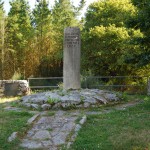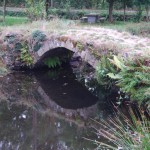Traveling in Spain: Camino Lugo―Santiago de Compostela. Part three
The morning in Lugo was misty and cool, and we all thought that it was going to rain and we would have to make our Camino1 under the rain. It was rather unpleasant, but we were ready for that.
(1Camino – the Way of Saint James – El Camino de Santiago — is a famous pilgrim route to the tomb of Apostle James in Spanish city Santiago de Compostela, the major part of which lies in Northern Spain. Because of its high popularity and expansive road network this route had a great significance for the promotion of achievements of civilization in the epoch of the Middle Ages. It is listed among the objects of the World Heritage by UNESCO).
We refused to eat breakfast at the hotel and instead decided to have a Galician breakfast in one of the local cafes. But first we had to visit the Cathedral of Lugo and receive our pilgrim certificates; in Spanish they are called the Credencials.
After we walked a little distance and entered through one of the gates in the Roman wall, we came out to the city square. Right behind the gates, adjacent to the square, the Cathedral of Saint Mary in Lugo was solemnly soaring.
As early as in 755, on the site of the current cathedral there was a little church in Lugo. But times changed, and in the 12th century Bishop Peter III ordered to build a new cathedral in the Romanesque style, which was popular then, in the place of the old church. The construction started in 1129 and lasted for more than one hundred years; only in 1273 the cathedral was finally finished. Built in the Romanesque style, the Cathedral in Lugo underwent some changes as time went by. Later renovations and reconstructions added the features of Gothic style, and Baroque style with elements of the Classicism to the original Romanesque style. The Cathedral gained its entire main façade and towers during the reconstruction of 1769.
The length of the cathedral is 85 meters and in layout it has the shape of a Latin cross.
The pearl of the Cathedral in Lugo is its altar, built in the Renaissance times and decorated by a Dutch master of the 16th century (Cornelis de Holanda). After the Lisbon earthquake of 1755, the altar was destroyed, and now its fragments can be seen in different parts of the Cathedral.
At the present time, the highlights of the cathedral’s ensemble are the cloister in Baroque style and the chapel with the alabaster statue of Our Lady of the Large Eyes (la Virgen de los Ojos Grandes). Above the northern portal of the cathedral one can see the image of Christ.
According to the current tradition, the statue of Our Lady of the Large Eyes is the heavenly patron of Lugo; and it is believed to be one of the oldest images of Virgin Mary. The unusual look of the Mother of God, which is credited with numerous miracles, was the reason why the image received another name – the Holy Virgin of the Large Eyes. There are recorded cases of the healings of paralyzed people.
The holy day of Our Lady of the Large Eyes is celebrated on August 15 each year, and the statue itself is the most beautiful statue in Spain. The age of the statue is unknown; some believe that the statue was created in the period of time between the 10th and 12th centuries. There is also a legend, according to which this image was created by Saint Santiago himself (Apostle James, son of Zebedee) in the first century by transforming an idol image.
On August 15 of 1954, the citizens of Lugo presented their patron with a medal made of pure gold, and fifty years before that they laid a crown on her head. Our Lady defended her city for many centuries, and because of this fact she is also called the Lady of Victories. In the difficult times and troublesome years, priests, kings, and common people fell at her feet, and always Our Lady of the Large Eyes helped – both at the time of the Reconquista, and during different battles fought by Alfonso II, who attributed his victories to her intercession. In the chronicles, there is an address of Saint Bermudo to the image of Our Lady, in which he calls her, “Senora and Our Lady, the Queen of Virgins and Mother of Light…”
In the Cathedral we were welcomed by a nun, who told us in details about the Cathedral and its history, and showed us the main attractions and relics of the cathedral; when this interesting tour was over, we were presented with the Credentials, stamped with the first marks and seals. Having received the instructions and having been sustained with spiritual food, we headed for the nearest café to eat our breakfast.
The café where we decided to eat breakfast enjoys great popularity with both the local people and the tourists; and it is so popular because you can have a traditional Galician breakfast there. We ordered an assortment of tapas, traditional omelette-tortilla, and… cava – Spanish sparkling wine, which should be drunk in the mornings. Our choice did not surprise anyone around us, because this is a tradition, and a very old one – to drink sparkling wine in the beginning of each day. After eating a substantial breakfast we were ready for the first day of our Camino.
After meeting our guide Andrei and discussing some technicalities, signing out from the hotel, grabbing our backpacks and water, putting on our scallop shells – the distinctive signs of the pilgrims, we set out on our journey.
Our Camino began with the “morning ascent.” This is how Slava calls the move that starts with climbing up. It was easy and nice to walk. As soon as we walked outside the city, we crossed a bridge over a river, and turning left immediately after the bridge, we walked straight going up higher and higher, using signs in the shape of scallop shells for direction that pointed us to the way to Saint James. By that time the mist rolled away, and the sun came out.
We walked on the very first original Camino, which is called Camino Primitivo, being the first known pilgrims’ way leading to Santiago. As early as in the 9th century, King of Asturias Alfonso II made this pilgrimage to visit the discovered tomb of Apostle James.
On the first day, we planned to walk to Ferreira and stay at the “O Pino” roadside hotel. The distance between Lugo and Ferreira is a little over 27 kilometers, and, as we walked, we enjoyed the scenery around us and the local colour of the Galician villages. Small villages gave way to the fields, and the fields smoothly flowed into the woods. It was like that during the whole first day of our journey.
In some places the Way of Saint James from a path turns into a deep furrow, and, while you are walking in this path-rut, you understand that the path turned into a furrow because for over one thousand years it had been trodden by pilgrims – day and night, using special signs and the Milky Way for their direction.
We saw many interesting buildings along the way; many of them were over a thousand years old – and these constructions are still being used directly for their intended purpose. In every village, no matter how small it was, there were its own churches, with their steeples soaring high above all the houses, interrupting the rural quiet with their bells’ chimes.
We were especially amused and surprised to see the strange, or at least that is how they looked to us, constructions made of stone and bricks that looked like small, almost childish houses on pillars-legs with tile roofs, decorated with stone crosses and crucifixes. It seemed to us that these houses were used by the local people for sacral2 purposes. But in reality it turned out that they were nothing less than the traditional Spanish grain stores that are called horreos in the local dialect. And the legs-pillars are needed to save the crop from rodents.
(2Sacral (from Latin sacrum — something sacred, devoted to gods) — in a broader sense it denotes everything divine, religious, heavenly, not of this world, irrational, mystical, different from common things, ideas, and notions. The meaning of the word sacral encompasses not only the realm of religious things, but a wider range of notions related to magic, esotery, mystics, and holistic teachings).
Our attention was also attracted to the springs of water. The Spanish take a great care of their springs. Some springs have been used for thousands of years and the water in them is still tasty and invigorating. Almost all the springs are well kept. Many springs are planted around with fruit trees, and in their shade one can take rest and philosophize to the sound of plashing water that carries away your anxiety and bad memories.
Having walked about fifteen kilometers, we decided to have a little rest, finding a comfortable place for ourselves under a spreading oak tree. After we rested and gathered strength, and got a few “knocks on the head” from the falling acorns, we continued the journey. We had to cover about ten more kilometers to the roadside cafeteria, where we planned to have a late dinner. While we walked and carried on our conversation, enjoying the beauty of the landscapes surrounding us, we did not even notice how we reached an intersection with a few buildings and a rural cafe standing there with a perfectly preserved old Roman road sign.
Our road dinner altogether consisted of Spanish delicacies. On a huge wooden dish showed off the generous portions of seasoned jamon, savoury chorizo, home-made cheese, and fresh baked bread, and all of it was accompanied with an excellent white wine. After such a substantial dinner and a little rest we headed for the “O Pino” Hotel in Ferreira, where we planned to spend the night and eat supper.
The hotel where we stayed was on the Way of Saint James at the beginning of the settlement. The windows of our hotel rooms looked out on a little garden that ended at a small river in which the ducks were playing, and on its banks some turkeys grazed, calling to each other from time to time. Behind the river we could see corn fields, green expanses and the woods. Close to the hotel there was a little stone bridge of the Roman times.
The hotel’s owner, who made the pilgrimage to Santiago-de-Compostela many times himself, cooked what was truly a royal supper for us that consisted of a salad with ripe peppers and fragrant tomatoes, juicy crisp beef stakes, aromatic lamb ribs, omelette-tortilla, polbo á galega – traditional Galician octopus dish, and the best white wine. For dessert, the well-known among the pilgrims almond pie Santiago was prepared, which was served with a cortado (espresso with a small amount of milk added to it), and in the end the owner treated us to the real home-made vodka and herb infusion liquor which he made himself.
Having had a substantial supper, we thanked our generous host, and each one walked to his own room to rest. Tomorrow, there was the second day of our Camino and the new adventures awaiting us.


